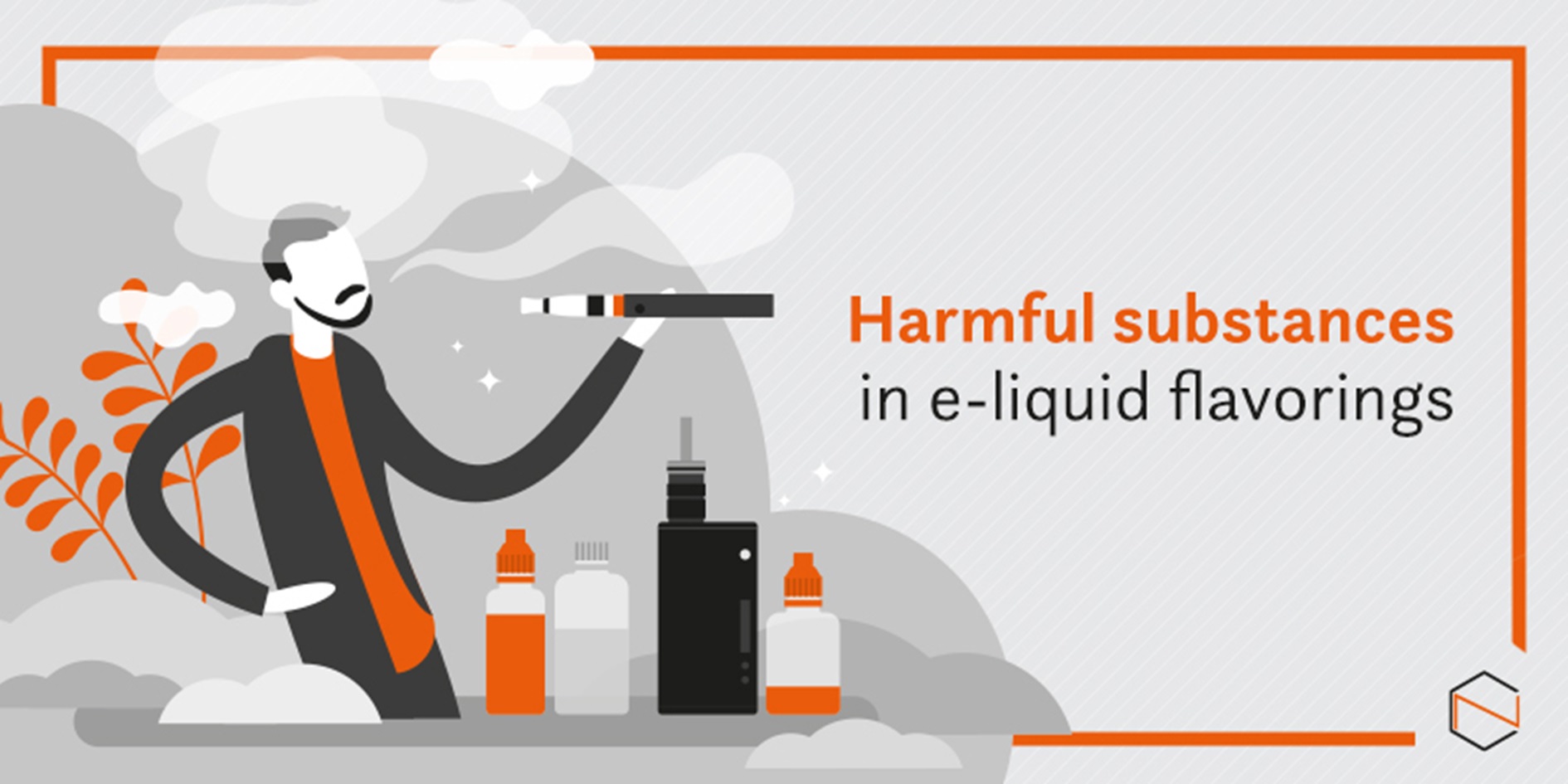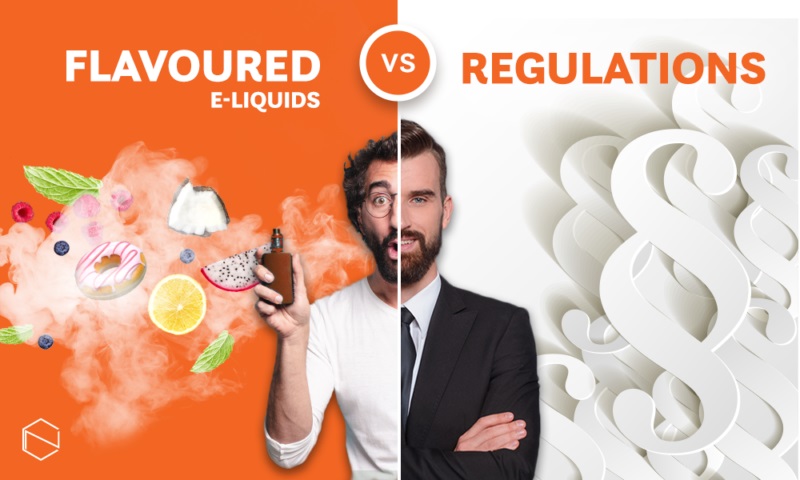
Although e-liquids are a much less harmful alternative to traditional cigarettes, manufacturers should be aware that some e-liquid flavorings might contain certain undesired substances. Flavorings from unknown/poor-quality suppliers might cause harm, due to their unreliable composition. Although these substances are typically not found in high volumes, they’re often present at levels significant enough to be the reason to find an alternative flavoring without those substances.
What are the harmful substances in e-liquid flavourings?
Even though, according to the British NHS, e-cigarettes are approximately 95% less harmful than smoking, there still might be some unwanted substances that are being used in flavorings. Manufacturers of e-cigarettes should be always aware that there are some substances they should avoid:
- Acrylamide: this chemical is a known carcinogen and neurotoxin.
- Diacetyl: this compound may also cause harm, but only if it’s inhaled over time. It’s used as a flavoring agent to give drink flavors like butter-vanilla aroma. It can also cause bronchiolitis.
- Formaldehyde: can react with nitrates in e-liquids and form carcinogenic nitrosamines.
- Acetylpropionyl: a strong irritant, that can be absorbed into the bloodstream.
Let us state, that the aforementioned substances are present not only in e-liquids. For example, diacetyl and acetylpropionyl are used in the food industry. They can cause lung damage, even when inhaled in very small amounts. Moreover, they may cause a decline in human respiratory function.
What’s inside e-liquid flavourings?
E-liquid flavorings might contain some unwanted substances like diacetyl or acetylpropionyl. The type of undesired substances, released when heating the liquid in an e-cigarette, depends on the added aroma.
For this reason, it is mighty important to always carefully read the documentation attached to a given raw material. Moreover, a reliable supplier should always be able to provide Safety Data Sheets and/or Certificates of Quality to prove their own transparency. If you don’t know what to pay attention to when reading the documentation accompanying the raw materials, you can check our previous article on this topic: How to read product certificates?
Remember that aromas are highly complex chemical mixtures. Their composition may include up to several hundred ingredients, and in accordance with the TPD directive, with a concentration equal to or greater than 0,1 %, they are not considered confidential and should be mentioned on the label. Therefore, if propionyl, or another chemical compound are present in the composition of a given aroma in a lower amount, they may not be shown on the packaging.
Another legislation that covers chemicals is CLP. It states, that the label on the packaging must contain a list of A1 category sensitizing substances that appear in the number of 0,01%, and more, of the whole product.
To sum up, depending on the regulations, the list of components on the label or in the MSDS will vary, based on the substances’ type and their quantity.
What is also important, full traceability of raw materials is a must! You should always be able to identify the source of any raw material used in the production of a given e-liquid. That allows to fully influence and supervise the quality of the final product.
What vapers should know?
As reported by the UK Food Standards Agency (FSA), the estimated concentration of harmful substances in e-liquid flavorings is low.
Electronic cigarettes, or to be more precise, e-liquids are considered a novel method to help people quit or cut back on traditional cigarettes. If you are not already an opponent of smoking conventional tobacco products, then e-cigarettes are an attractive alternative. The good thing is that they are also much safer compared to traditional smokes due to their reduced risks for users involved. As far as vaping liquids are concerned, there are several precautions smokers must keep in mind when purchasing their favorite juice bottle:
- First of all, while choosing an e-liquid, choose a brand that has been thoroughly tested and approved by authorities.
- Buy only from a legal source! Thanks to that, you will have a guarantee that a given e-liquid is safe and before entering the market was tested in the laboratory and approved by the authorities.
- Don’t add anything to e-liquid! Adding your own ingredients to e-liquids can have dramatic consequences. Even if it seems to you that a given substance is completely harmless to the organism, it can have tragic consequences when it is heated and inhaled. Adding your own ingredients to liquids in an e-cigarette can result in serious illness or even death!
- Another important thing is to consider the quality of e-liquids. Try to choose a reliable manufacturer, who can answer all questions regarding any substances in their flavourings.

What are the current regulations for e-liquid flavorings?
As for the European Union, all e-liquids put on sale must be laboratory tested in accordance with the TPD directive. This is to increase the safety of e-liquids and control the substances contained in the composition of the final products. The scope of TPD laboratory tests includes:
- Heavy metals
- Volatile Organic Compounds
- Aldehydes and ketones
- Tobacco-specific nitrosamines
- Nicotine, propylene glycol, and glycerin content
Despite the fact that e-liquids, and thus also aromas, used in the production of e-liquids, are tested in terms of safety of use, there is now a growing trend in many countries to ban the use of flavorings in e-liquids other than tobacco or menthol. Regulations concerning the e-liquids industry as well as e-cigarette flavors are changing dynamically. However, global trends to tighten policies are clearly visible. There is increasing regulatory pressure on flavours other than tobacco or menthol in e-liquids.
Some states of the United States (ex. New York, New Jersey) and several countries (Lithuania, Finland, Philippines) have already introduced bans on the sale of e-liquids with flavors other than, mainly, menthol or tobacco. All this to make the final product not so much attractive for consumers, especially for the youth. At the same time, some people believe that these restrictions also make e-liquids less attractive for cigarette smokers, discouraging them from quitting smoking.
At Chemnovatic we keep track of all legislative changes in the e-cigarette industry around the world and introduce the necessary changes. Therefore feel free to reach out to us if you need any consultations or advice at sales@chemnovatic.com. You can also follow the e-liquid industry regulations changes here.
Conclusion
Due to the great responsibility of e-liquid producers, we should make every effort to ensure the safety of e-cigarette users. The ability to track back and check the composition of raw materials used for e-liquid production enables full control over the final quality of the products. For this reason, it is worth choosing only reliable and transparent business partners who will guarantee us access to all documentation related to raw materials used for production.
And in case of any doubts just ask! Email us at sales@chemnovatic.com. Remember – a supplier who has nothing to hide will surely dispel all doubts and answer all questions.
Let’s grow your business together!
Subscribe to our newsletter and receive a free access to our e-mail course on raw materials for e-liquids production (and more!).
No spam, only valuable content we promise to send you.















